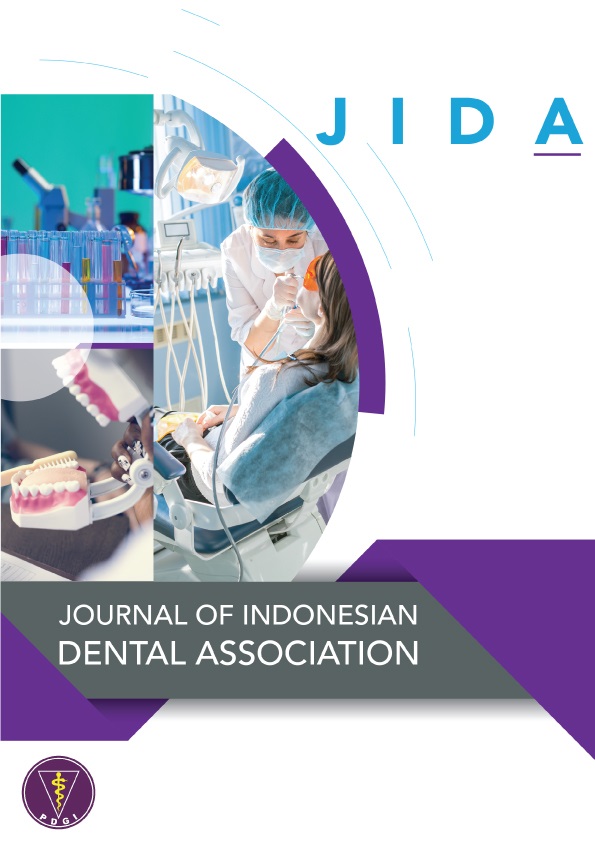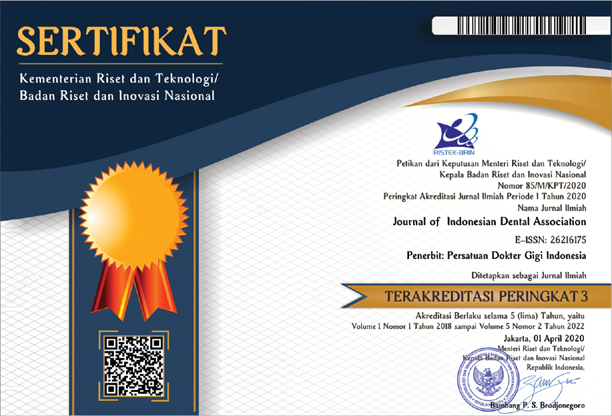Indonesian School Students’ Knowledge After Online Dental Health Education: A Scoping Review
Abstract
One way to prevent dental health problems is through Dental Health Education (DHE). Elementary, junior, and senior high school students are ideal participants for DHE, and it is expected that their knowledge will increase after receiving DHE. During the COVID-19 pandemic, DHE has adapted its traditional offline to online method using various educational media. This review aimed to identify the theoretical overview presented in the literature regarding Indonesian school students' knowledge after online DHE. Article searches by Google Scholar database and focusing on students' knowledge after online DHE. Selected articles were screened and structurally read by two persons. In this research, 853 articles identified. Subsequently, articles filtered and presented in a data extraction table with three categories: elementary, junior, and senior high school. There were 30 included articles: elementary school (n=18), junior high school (n=9), and senior high school students (n=3). In each inclusion article, the students' knowledge increased after online DHE, as evidenced by the rise in mean scores from pretest to posttest with significant test (p<0.05), if present. Dental health education media varied by level: elementary school = educational video, junior high school = Zoom Meetings, and senior high school = Instagram. In conclusion, the students' knowledge after online dental health education has increased through various media.References
1. Kementerian Kesehatan RI Badan Penelitan Pengembangan Kesehatan. Laporan Riskesdas 2018 Nasional. 2019;
2. World Health Organization. Strategy for oral health in South-East Asia 2013-2020. New Delhi: World Health Organization; 2013.
3. Supriyanto I, Insanuddin I. The effectiveness of the primary school dental health education extension program through the anjangsana (home visiting) approach using a daring method to attitudes about dental and mouth health during pandemi COVID-19 Bandung area. Jurnal Kesehatan Gigi. 2020; 8(1): 43–47.
4. Cooper A, O’Malley L, Elison S, et al. Primary school-based behavioural interventions for preventing caries. Cochrane Database Syst Rev. 2013;31:(5):CD009378.
5. Tandilangi M, Mintjelungan C, Wowor VN. Efektivitas dental health education dengan media animasi kartun terhadap perubahan perilaku kesehatan gigi dan mulut siswa SD Advent 02 Sario Manado. e-GiGi. 2016; 4(2): 133–135.
6. Salikun S, Supriyana S, Suwarsono S, Kusmana A, Setiadi Y. Integrated dental health monitoring using smart tooth brush and application. Journal of Health and Medical Sciences. 2021; 4(4): 73–80.
7. Utami W, Rahmawati I, Said F. Efektivitas penyuluhan metode daring menggunakan media phantom tentang cara menyikat gigi yang baik dan benar di masa pandemi COVID-19 di SMPN 5 Alalak Handil. Jurnal Annadaa. 2022; 9(2): 90–94.
8. Herwiana S, Laili EN. Exploring benefits and obstacles of online learning during the covid-19 pandemic in EFL students’ experiences. Qalamuna. 2022;14(1):61–72.
9. Fitri H, Fajrin N, Kasuma N, Wulandari RW, Sari SR, Ernesto G. The effectiveness of dental and oral health education for youth through online media. JDS. 2020; 7(1): 21–26.
10. Cambridge Assessment International Education. Global Education Census Report 2018. Cambridge: Cambridge Assessment International Education; 2018.
11. Fitri H, Rahmi E, Kasuma N. Differences in the effectiveness of online and offline dental and oral health education management for middle school children in the new normal era of covid 19. Jurnal Kesehatan Gigi. 2022; 9(1): 16–20.
12. Veeraiyan DN, Varghese SS, Rajasekar A, et al. Comparison of Interactive Teaching in Online and Offline Platforms among Dental Undergraduates. Int J Environ Res Public Health. 2022;19(6):1-8.
13. Pulimeno M, Piscitelli P, Salvatore C. School as ideal setting to promote health and wellbeing among young people. Health Promot Perspect. 2020;10(4):316–324.
14. Mayasari Y, Belanita B, Hertiana E. Online video game: the innovation of dental health education tools for children during pandemic. MIRSHuS. 2021; 1(1). 16-24.
15. Sukini S, Rinawati NK, Wiradona I. Differences in behavior after dental health counseling with zoom meetings for middle school students. Jurnal Kesehatan Gigi. 2021;8(2):21–124.
16. Kasuma N, Sumantri D, Nofika R, Nelis S, Fransiska A. Effectiveness of online oral health education during the COVID-19 Pandemic. Indian Journal of Forensic Medicine & Toxicology. 2020; 14(4): 4240–4248.
17. Gumilar MS, Muliadi M, Warsono W. Development of virtual Reality application for oral and dental health promotion on early childhood. Jurnal Kesehatan Gigi. 2022;9(2):103–110.
18. Utami FR, Yasmin A, Hartantri F, et al. Pengaruh video penyuluhan kesehatan tentang obesitas bagi anak usia sekolah dasar. Buletin Kesehatan 2021;5(1):12-23.
19. Widodorini T, Salsabila AN. The use of the modified twister educational game application as dental and oral health education media. Mal J Med Health Sci. 2023;1(1):28-32.
20. Hung C-M, Huang I, Hwang G-J. Effects of digital game-based learning on students’ self-efficacy, motivation, anxiety, and achievements in learning mathematics. Journal of Computers in Education 2014;1(2):151–166.
21. Ngatemi N, Purnama T, Rahmadhani NM. Dental health education with zoom meeting application during the COVID-19 pandemic: is it effective. IJMRA. 2021;4(2):1891-1894.
22. Setiawati PR, Putri TA, Isni K. The effect of reproductive health education on the knowledge level of adolescent pre-marriage sex in Riau Province, Indonesia. Jurnal Cakrawala Promkes. 2022;5(1):8–17.
23. Ratnasari DP, Lies EP. Instagram sebagai media edukasi peningkatan pengetahuan kesehatan gigi dan mulut. Jurnal Kesehatan Gigi. 2021; 8(2): 51–57.
24. Septiana R, Anggreni E. Google sites as a media for promoting dental health in increasing knowledge in high school children. Journal CoE. 2023;1(2):53–58.
25. Fitri H, Kasuma N, Aulia R, Wulandari R. Edukasi kesehatan gigi dan mulut sejak dini bagi siswa di SMA Pembangunan Laboratorium UNP Padang. Buletin Ilmiah Nagari Membangun. 2023;6(2):102–114.
26. Oktavianti R, Loisa R. Penggunaan media sosial sesuai nilai luhur budaya di kalangan siswa SMA. Jurnal Pengabdian Kepada Masyarakat. 2017;3(1):86–95.
27. Maharani M, Rachman MZ, Suharno B. Pengaruh edukasi media video terhadap pengetahuan tentang aktivitas fisik bagi pengguna sosial media Instagram. Jurnal Pendidikan Kesehatan. 2021;10(2):201–208.
28. Purmadi A, Surjono H. Pengembangan bahan ajar berbasis web berdasarkan gaya belajar siswa untuk mata pelajaran Fisika. Jurnal Inovasi Teknologi Pendidikan. 2016;3(2):151–165.
29. Kurniawan J, Dewi O, Leonita E, Nurlisis N, Muryanto I. Efektifitas media sosial youtube modifikasi teka teki silang dalam edukasi kesehatan gigi dan mulut pada siswa - siswi SDN 015 Sungai Sirih. Jurnal Kesehatan Komunitas 2021;7(1):90–96.
30. Pay MN, Wali A , Pinat LM, Eluama MS. The effect of online counseling puzzle and poster media on dental caries knowledge. JDHT. 2023;4(1):1–7.
31. Henry SA, Agusmawanti A, Agustin ED. The effect of online counseling through video teleconference in improving of knowledge of oral and dental health in children. MEDALI. 2022; 4(2): 147-151.
2. World Health Organization. Strategy for oral health in South-East Asia 2013-2020. New Delhi: World Health Organization; 2013.
3. Supriyanto I, Insanuddin I. The effectiveness of the primary school dental health education extension program through the anjangsana (home visiting) approach using a daring method to attitudes about dental and mouth health during pandemi COVID-19 Bandung area. Jurnal Kesehatan Gigi. 2020; 8(1): 43–47.
4. Cooper A, O’Malley L, Elison S, et al. Primary school-based behavioural interventions for preventing caries. Cochrane Database Syst Rev. 2013;31:(5):CD009378.
5. Tandilangi M, Mintjelungan C, Wowor VN. Efektivitas dental health education dengan media animasi kartun terhadap perubahan perilaku kesehatan gigi dan mulut siswa SD Advent 02 Sario Manado. e-GiGi. 2016; 4(2): 133–135.
6. Salikun S, Supriyana S, Suwarsono S, Kusmana A, Setiadi Y. Integrated dental health monitoring using smart tooth brush and application. Journal of Health and Medical Sciences. 2021; 4(4): 73–80.
7. Utami W, Rahmawati I, Said F. Efektivitas penyuluhan metode daring menggunakan media phantom tentang cara menyikat gigi yang baik dan benar di masa pandemi COVID-19 di SMPN 5 Alalak Handil. Jurnal Annadaa. 2022; 9(2): 90–94.
8. Herwiana S, Laili EN. Exploring benefits and obstacles of online learning during the covid-19 pandemic in EFL students’ experiences. Qalamuna. 2022;14(1):61–72.
9. Fitri H, Fajrin N, Kasuma N, Wulandari RW, Sari SR, Ernesto G. The effectiveness of dental and oral health education for youth through online media. JDS. 2020; 7(1): 21–26.
10. Cambridge Assessment International Education. Global Education Census Report 2018. Cambridge: Cambridge Assessment International Education; 2018.
11. Fitri H, Rahmi E, Kasuma N. Differences in the effectiveness of online and offline dental and oral health education management for middle school children in the new normal era of covid 19. Jurnal Kesehatan Gigi. 2022; 9(1): 16–20.
12. Veeraiyan DN, Varghese SS, Rajasekar A, et al. Comparison of Interactive Teaching in Online and Offline Platforms among Dental Undergraduates. Int J Environ Res Public Health. 2022;19(6):1-8.
13. Pulimeno M, Piscitelli P, Salvatore C. School as ideal setting to promote health and wellbeing among young people. Health Promot Perspect. 2020;10(4):316–324.
14. Mayasari Y, Belanita B, Hertiana E. Online video game: the innovation of dental health education tools for children during pandemic. MIRSHuS. 2021; 1(1). 16-24.
15. Sukini S, Rinawati NK, Wiradona I. Differences in behavior after dental health counseling with zoom meetings for middle school students. Jurnal Kesehatan Gigi. 2021;8(2):21–124.
16. Kasuma N, Sumantri D, Nofika R, Nelis S, Fransiska A. Effectiveness of online oral health education during the COVID-19 Pandemic. Indian Journal of Forensic Medicine & Toxicology. 2020; 14(4): 4240–4248.
17. Gumilar MS, Muliadi M, Warsono W. Development of virtual Reality application for oral and dental health promotion on early childhood. Jurnal Kesehatan Gigi. 2022;9(2):103–110.
18. Utami FR, Yasmin A, Hartantri F, et al. Pengaruh video penyuluhan kesehatan tentang obesitas bagi anak usia sekolah dasar. Buletin Kesehatan 2021;5(1):12-23.
19. Widodorini T, Salsabila AN. The use of the modified twister educational game application as dental and oral health education media. Mal J Med Health Sci. 2023;1(1):28-32.
20. Hung C-M, Huang I, Hwang G-J. Effects of digital game-based learning on students’ self-efficacy, motivation, anxiety, and achievements in learning mathematics. Journal of Computers in Education 2014;1(2):151–166.
21. Ngatemi N, Purnama T, Rahmadhani NM. Dental health education with zoom meeting application during the COVID-19 pandemic: is it effective. IJMRA. 2021;4(2):1891-1894.
22. Setiawati PR, Putri TA, Isni K. The effect of reproductive health education on the knowledge level of adolescent pre-marriage sex in Riau Province, Indonesia. Jurnal Cakrawala Promkes. 2022;5(1):8–17.
23. Ratnasari DP, Lies EP. Instagram sebagai media edukasi peningkatan pengetahuan kesehatan gigi dan mulut. Jurnal Kesehatan Gigi. 2021; 8(2): 51–57.
24. Septiana R, Anggreni E. Google sites as a media for promoting dental health in increasing knowledge in high school children. Journal CoE. 2023;1(2):53–58.
25. Fitri H, Kasuma N, Aulia R, Wulandari R. Edukasi kesehatan gigi dan mulut sejak dini bagi siswa di SMA Pembangunan Laboratorium UNP Padang. Buletin Ilmiah Nagari Membangun. 2023;6(2):102–114.
26. Oktavianti R, Loisa R. Penggunaan media sosial sesuai nilai luhur budaya di kalangan siswa SMA. Jurnal Pengabdian Kepada Masyarakat. 2017;3(1):86–95.
27. Maharani M, Rachman MZ, Suharno B. Pengaruh edukasi media video terhadap pengetahuan tentang aktivitas fisik bagi pengguna sosial media Instagram. Jurnal Pendidikan Kesehatan. 2021;10(2):201–208.
28. Purmadi A, Surjono H. Pengembangan bahan ajar berbasis web berdasarkan gaya belajar siswa untuk mata pelajaran Fisika. Jurnal Inovasi Teknologi Pendidikan. 2016;3(2):151–165.
29. Kurniawan J, Dewi O, Leonita E, Nurlisis N, Muryanto I. Efektifitas media sosial youtube modifikasi teka teki silang dalam edukasi kesehatan gigi dan mulut pada siswa - siswi SDN 015 Sungai Sirih. Jurnal Kesehatan Komunitas 2021;7(1):90–96.
30. Pay MN, Wali A , Pinat LM, Eluama MS. The effect of online counseling puzzle and poster media on dental caries knowledge. JDHT. 2023;4(1):1–7.
31. Henry SA, Agusmawanti A, Agustin ED. The effect of online counseling through video teleconference in improving of knowledge of oral and dental health in children. MEDALI. 2022; 4(2): 147-151.
Published
2025-05-02
How to Cite
PANJAITAN, Caesary Cloudya; AMALYA, Nisa Ikhlasul.
Indonesian School Students’ Knowledge After Online Dental Health Education: A Scoping Review.
Journal of Indonesian Dental Association, [S.l.], v. 8, n. 1, p. 45-51, may 2025.
ISSN 2621-6175.
Available at: <http://jurnal.pdgi.or.id/index.php/jida/article/view/1156>. Date accessed: 10 dec. 2025.
doi: https://doi.org/10.32793/jida.v8i1.1156.
Issue
Section
Review Article

This work is licensed under a Creative Commons Attribution-NonCommercial 4.0 International License.












